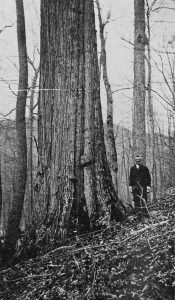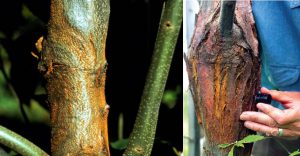The story of the American chestnut tree reads a bit like the plot of a good comeback story. The once mighty champion falls on hard times and is nearly defeated until a devoted team of supporters rallies around to stage a triumphant return. In this case, the champion is the American chestnut, once the mighty king of the forests of the eastern United States, which was almost completely wiped out by an invasive blight. Today, the American chestnut is returning from the brink of extinction, thanks largely to the efforts of dedicated scientists, and may one day soon regain its former glory.

The American chestnut (Castanea dentate) was once the predominant tree in the eastern half of the United States and it served a vital role in colonial life and early American economics. With a range of more than 30 million acres, it has been estimated that three to four billion American chestnut trees covered this area at the tree’s peak.
Because they reached 100 feet in height and grew thicker than 12 feet in diameter, the American chestnut tree earned the nickname “redwoods of the East.” The lifespan of the tree was two to three hundred years. The trees grew fast, large, and strong, and resistant to rot. Lumber from the American chestnut was ideal for log cabins, fence posts, floor boards, and railroad ties. In fact, the tree made up a quarter of all eastern hardwood, making it the tree with the highest economic value.
A single tree could produce as many as 6,000 chestnuts, a sweet nut with a slight carrot flavor. Chestnuts are high in fiber, low in fat, and loaded with protein, carbohydrates, and vitamin C. Because the nuts reached maturity in late Fall,they became a special treat to eat roasted during the holiday season.
But humans weren’t the only ones who consumed the delicious nut. Settlers often fattened their livestock before slaughter time by allowing them to forage in a chestnut forest. Deer, bear, turkey, and other wildlife relied on fallen chestnuts. In late spring, each American chestnut tree would explode in blossoms that supported populations of honeybees and other pollinating insects.

All this changed around the early 1900s when Chinese chestnut trees (Castanea mollissima) brought into the United States carried with them Cryphonectria parasitica, the cause of the chestnut blight. Within 50 years, the decimation was complete.
Down but not completely out, the American chestnut survived total extinction because of its ability to send up sprouts from stumps of trees that had been harvested or felled naturally. The fledgling trees would grow, and appear to thrive, for a number of years, but the blight would eventually claim them too. But the sprouting continued. One estimate by a USDA Forest Service survey in New York showed that there may be as many as 60 million sprouts in that state alone. This is just the raw genetic material needed to jump start a comeback.
Since the 1930s, geneticists with the USDA have worked on cross-breeding the American chestnut with the Chinese chestnut, the very culprit that brought the blight into the country in the first place. But the Chinese chestnut is naturally resistant to the blight, therefore, scientists worked to create a hybrid that retained the superior qualities of the American chestnut, while adding the Chinese chestnut’s fungal resistance. The trees that were produced, at first, seemed promising, but they too, eventually succumbed to the blight. After crossing generation after generation of American and Chinese chestnut trees, the USDA scientists seemed close to success. They produced a single hybrid tree, named the Clapper tree, that grew tall and straight from 1946 until 1963, when is began showing signs of the fungal blight, which eventually killed the tree in the mid-1970s.
In the early 1980s, a corn geneticist named Charles Burnham read the USDA’s published results on their failed attempts to cross-breed the American chestnut with the Chinese chestnut. Burnham noticed that the scientists working on the project failed to practice one of the key principles of breeding for resistance – backcrossing.

Backcrossing is the process of crossing a hybrid back to one of its parents, or a tree that is genetically similar to the parent tree, in order to produce an offspring that exhibits the desired traits of one of the parent trees, while eliminating the undesirable qualities. In the case of the chestnut, the goal was to produce a tree that is tall, straight, and quick-growing like the American chestnut, and the has the blight resistance like the Chinese chestnut, but removing the undesirable traits like the low, shrubby growth of the Chinese chestnut.
Because the USDA’s cross-breeding program was deemed a failure and shut down, Burnham and a few fellow scientists started a private, non-profit organization, the American Chestnut Foundation, in 1983, to utilize backcrossing techniques to resurrect the American chestnut. Their goal was to produce a viable hybrid in several generations. In fact, it takes a minimum of six generations before successful hybrids can be developed through backcrossing. Given the long growth cycle of trees (as compared to crops like corn), cross breeding six-plus generations of trees takes time, and most of it is down time. Although promising trees are currently being planted and monitored, it could be decades before they are declares a success.
Meanwhile, another research project being conducted may help in the restoration of the American chestnut tree. This one addresses the blight itself.
Scientists have discovered a naturally-occurring virus that infects and weakens the chestnut blight. This virus is a hypovirulence, a fungal virus that reduces the strength and virility of another fungal virus. Across Europe, this virus has prevented the decimation of the chestnut trees that occurred in the United States. Virologist Donald Nuss of the University of Maryland’s Biotechnology Center was awarded a grant by the National Institutes of Health to study the American strain of the virus to determine why it does not occur widespread like its European cousin. Nuss has been able to clone the hypovirus and inject it into a chestnut blight, where he observed that the effects of the blight were diminished.
Early indications show that this newly-introduced hypovirus is spreading effectively on its own through American forests. It is the hope that this hypovirus will weaken the fungal blight on the new hybrid American chestnuts. The combination of both research projects may mean that the American chestnut has a fighting chance of regaining its place at the pinnacle of the forest.
Sources:
Horton, Tom. “Revival of the American Chestnut.” American Forests, N.p., Winter 2010. Web. 11 Apr. 2017.
“Restoration of the American Chestnut.” The American Chestnut Foundation. N.p., n.d. Web. 11 Apr. 2017.
SUNY-ESF Office of Communications. “Background on American Chestnut and Chestnut Blight.” SUNY-ESF: The American Chestnut Research and Restoration Project. N.p. 3 Jan. 2017. Web. 11 Apr. 2017.
